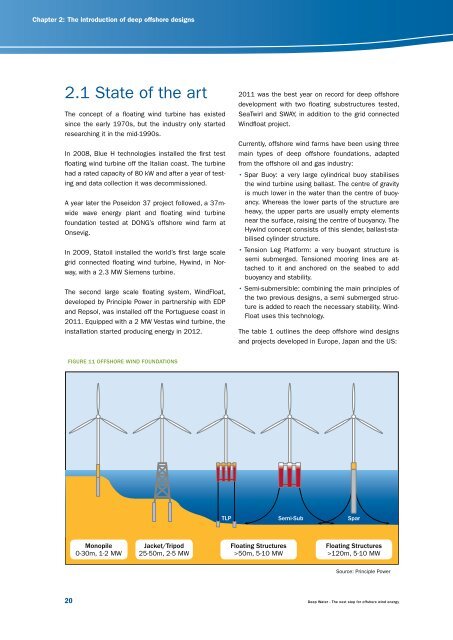Deep_Water
Deep_Water
Deep_Water
You also want an ePaper? Increase the reach of your titles
YUMPU automatically turns print PDFs into web optimized ePapers that Google loves.
Chapter 2: The introduction of deep offshore designs<br />
2.1 State of the art<br />
The concept of a floating wind turbine has existed<br />
since the early 1970s, but the industry only started<br />
researching it in the mid-1990s.<br />
In 2008, Blue H technologies installed the first test<br />
floating wind turbine off the Italian coast. The turbine<br />
had a rated capacity of 80 kW and after a year of testing<br />
and data collection it was decommissioned.<br />
A year later the Poseidon 37 project followed, a 37mwide<br />
wave energy plant and floating wind turbine<br />
foundation tested at DONG’s offshore wind farm at<br />
Onsevig.<br />
In 2009, Statoil installed the world’s first large scale<br />
grid connected floating wind turbine, Hywind, in Norway,<br />
with a 2.3 MW Siemens turbine.<br />
The second large scale floating system, WindFloat,<br />
developed by Principle Power in partnership with EDP<br />
and Repsol, was installed off the Portuguese coast in<br />
2011. Equipped with a 2 MW Vestas wind turbine, the<br />
installation started producing energy in 2012.<br />
2011 was the best year on record for deep offshore<br />
development with two floating substructures tested,<br />
SeaTwirl and SWAY, in addition to the grid connected<br />
Windfloat project.<br />
Currently, offshore wind farms have been using three<br />
main types of deep offshore foundations, adapted<br />
from the offshore oil and gas industry:<br />
• Spar Buoy: a very large cylindrical buoy stabilises<br />
the wind turbine using ballast. The centre of gravity<br />
is much lower in the water than the centre of buoyancy.<br />
Whereas the lower parts of the structure are<br />
heavy, the upper parts are usually empty elements<br />
near the surface, raising the centre of buoyancy. The<br />
Hywind concept consists of this slender, ballast-stabilised<br />
cylinder structure.<br />
• Tension Leg Platform: a very buoyant structure is<br />
semi submerged. Tensioned mooring lines are attached<br />
to it and anchored on the seabed to add<br />
buoyancy and stability.<br />
• Semi-submersible: combining the main principles of<br />
the two previous designs, a semi submerged structure<br />
is added to reach the necessary stability. Wind-<br />
Float uses this technology.<br />
The table 1 outlines the deep offshore wind designs<br />
and projects developed in Europe, Japan and the US:<br />
Figure 11 Offshore wind foundations<br />
TLP Semi-Sub Spar<br />
Monopile<br />
0-30m, 1-2 MW<br />
Jacket/Tripod<br />
25-50m, 2-5 MW<br />
Floating Structures<br />
>50m, 5-10 MW<br />
Floating Structures<br />
>120m, 5-10 MW<br />
<br />
Source: Principle Power<br />
20 <strong>Deep</strong> <strong>Water</strong> - The next step for offshore wind energy


